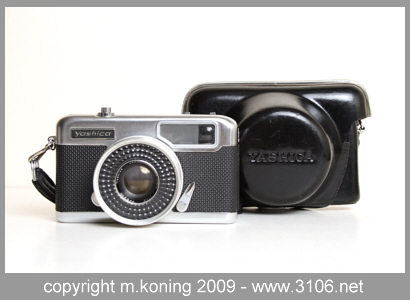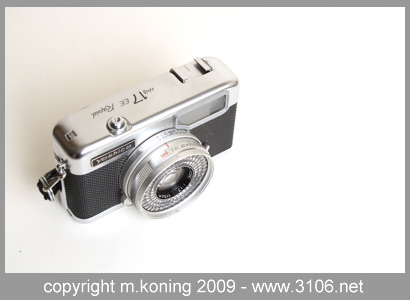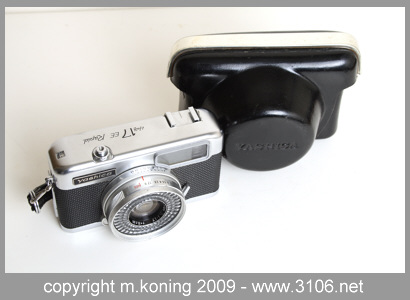3106.photography
Created 13 May 2009 ... Updated 13 May 2009
|
Yashica Half 17EE Rapid
|
|||||||||||||||||||||||||||||||||||||||||||||||||||||||||||||||||||||||||||||||||||||||||||||||||||||
 After a steady increase in quality of black-and-white film and the expense of colour film, the 1960s market was ready to accept smaller negatives. Instead of developing a new film format, as Kodak had tried several times, mostly without much success, it was decided to use standard 35mm (type 135) film and only light an area half the standard 24x36 mm size; half format was born with resulting negatives of 18x24 mm size and doubling the number of pictures on a standard 35mm film. Also note that due to this split, the pictures on the negative film are tilted by 90°, making portrait format the basic format, taking pictures in landscape format are done by turning the cameras on its side, just the opposite of other 35mm cameras.
After a steady increase in quality of black-and-white film and the expense of colour film, the 1960s market was ready to accept smaller negatives. Instead of developing a new film format, as Kodak had tried several times, mostly without much success, it was decided to use standard 35mm (type 135) film and only light an area half the standard 24x36 mm size; half format was born with resulting negatives of 18x24 mm size and doubling the number of pictures on a standard 35mm film. Also note that due to this split, the pictures on the negative film are tilted by 90°, making portrait format the basic format, taking pictures in landscape format are done by turning the cameras on its side, just the opposite of other 35mm cameras.
The "Rapid" designation means this camera is for use with Agfa Rapid film cartridges. In 1963 Kodak introduced the Instamatic system (type 126) mainly for, amongst other nifty features, easier film loading. For patent reasons, Agfa could not introduce a similar system so that took the system introduced with the Agfa Karat line of cameras, improved it in order to have the camera sense the film speed and sold it under the new "Rapid system" name. The film contained in the Rapid cartridges were of the standard 35mm format so that exsisting development and printing machines could be used. Maximum film length in the cartridges was 60 centimeters for approximately 30 exposures on the Yashica Half 17 EE. This opposed to 180 centimers for a 36 exposure 35mm filmstrip. As with Instamatic cameras, the Rapid format was actually meant to be square, in this case 24x24 millimeters. However the Yashica half frame used the material as it's 35mm half frame cousin, namely for the 18x24 mm format. The Agfa Silette Rapid used it as with full frame 35mm film, i.e. 36 x 24 mm. When loading the cartridges in the camera, the new cartridge was put in, the camera back closed and the film wound onto the empty spool. The film would wind onto the empty spool by itself. When all negative material was used, the film was not wound back but the full (formerly empty) spool was taken out and the now empty spool placed in place of the take up spool. So there was no need to wind back the film, saving some time when changing films. However, probably because of Kodak's global market presence, the Instamatic system became most popular and Agfa had to discontinue their Rapid system in the 1970s. In line with the half-frame "Olympus Pen E" Series cameras, Yashica decided to also build a line of 35mm half frame cameras. The Half 17 EE Rapid is quite heavy for such a small camera. The exposure measuring selenium cell ("EE" for Electric Eye) around the lens enabled automatic exposure, which was fully automatic or aperture priority with automatic shutter speed. Placing the cell around the lens is actually a good idea for rangefinders since it will automatically take filterfactors into consideration when a filter is placed over the lens. When the camera is not in use, it's a good idea to place the lens cap over the lens in order to conserve the selenium cell, which otherwise may slowly get used up over time. The camera does not need a battery. Who said that cameras designated for the low-end of the market could not be of high-quality and good looks? This camera is very sturdy and the chrome plate on top is just so smooth and beautiful that one could think this was a very expensive model at its time. The fun thing is that this camera is the same as the Yashica EZ-Matic but instead of 126 Instamatic film cartridges, it uses 35mm film in Rapid cartridges. Most parts however are shared with the Yashica EZ Matic, including the beautiful chrome top. Controls are very basic, there is, just as with the EZ matic an automatic and aperture priority setting, a focus scale and that's about it. As compared to the EZ matic, because of the different film formats, the lens is different. Whereas the EZ has a Yashinon 1:2.7 f=37 mm lens, the Half 17 has a Yashinon 1:1.7 f=32 mm lens. The aperture and focus rings have also be swapped, the focus ring is at the front this time. My camera is still like new, no scratches and all functions work as smoothly as when the camera left the factory. Because of the unavailability of Rapid film, I haven't actually tried using the camera but it feels and looks nice enough to keep it :o) Overview of Yashica produced half-frame cameras Information partly from SubClub
The reason for me to buy this camera was it's cool 1960 chrome look with the rounded edges. It's surprisingly heavy as it's made mainly from metal, which also makes the camera fairly sturdy. The Electric Eye Exposure meter cells around the lens make it look cool too. |
|||||||||||||||||||||||||||||||||||||||||||||||||||||||||||||||||||||||||||||||||||||||||||||||||||||
Specifications
|
|||||||||||||||||||||||||||||||||||||||||||||||||||||||||||||||||||||||||||||||||||||||||||||||||||||

|
|||||||||||||||||||||||||||||||||||||||||||||||||||||||||||||||||||||||||||||||||||||||||||||||||||||
|
|||||||||||||||||||||||||||||||||||||||||||||||||||||||||||||||||||||||||||||||||||||||||||||||||||||

|
|||||||||||||||||||||||||||||||||||||||||||||||||||||||||||||||||||||||||||||||||||||||||||||||||||||
All photos copyright of M. Koning 1997 - 2009
Note: Using the text or images on this site in an auction such as eBay without permission is a violation of your ebay Terms of Service. I will report you to ebay if I discover such a violation taking place. This may result in your account being cancelled. I also reserve the right to file claim for civil penalties.
Return